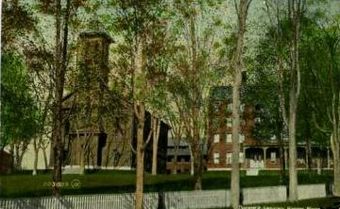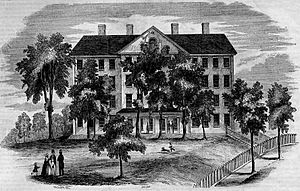Bangor Theological Seminary facts for kids
Quick facts for kids |
|
|
Bangor Theological Seminary Historic District
|
|

Bangor Theological Seminary, early 1900s
|
|
| Location | Union St., Bangor, Maine |
|---|---|
| Area | 7.5 acres (3.0 ha) |
| Built | 1827 |
| Architect | multiple |
| Architectural style | Late Victorian, Federal, Greek Revival |
| NRHP reference No. | 77000080 |
| Added to NRHP | August 2, 1977 |
Bangor Theological Seminary was a special school in Maine, USA. It was founded in 1814 and helped people learn about Christianity and prepare for church leadership. It was known for being "ecumenical," which means it welcomed students and teachers from many different Christian groups.
The seminary had campuses in both Bangor, Maine and Portland, Maine. It was the only school of its kind in northern New England that offered advanced degrees in religion. These degrees included the Master of Divinity (M.Div.), Master of Arts (MA), and Doctor of Ministry (D.Min.).
Bangor Theological Seminary closed its doors on June 22, 2013, after nearly 200 years.
Contents
A Look Back: The Seminary's Story

Bangor Theological Seminary began with a more traditional approach to religious studies. A group of church leaders wanted to create a place for theological study in northern New England. They met in Portland on July 27, 1811, to plan the school.
One of the first leaders, Jonathan Fisher, explained why the school was so important. He believed that if they waited for other schools to provide trained ministers, other groups would fill the need. He wanted to make sure ministers were well-educated.
The school received its official permission, called a charter, on February 25, 1814. This was from the Massachusetts General Court. It was first called the Maine Charity School. It shared space with Hampden Academy before moving to Bangor in 1819.
Growing and Changing Over Time
The seminary began to take its later shape under the leadership of Reverend Enoch Pond. He was a well-known scholar and writer. Pond joined the faculty in 1833 and became president in 1856. He stayed in that role until he passed away in 1882.
In 1858, the school faced financial difficulties. It even thought about joining with Bowdoin College or Andover Theological Seminary. However, it managed to recover and continue on its own.
In 2005, the seminary sold its historic campus. It then moved to the campus of Husson University.
The Seminary's Final Years
When it closed in May 2013, Bangor Theological Seminary offered several advanced degrees. These included the Master of Divinity, Master of Arts, and Doctor of Ministry. The school was known for being ecumenical, meaning it welcomed students and teachers from over a dozen different religious traditions.
It was one of only seven United Church of Christ seminaries in the United States. It was also the only accredited theological school in northern New England.
Today, a non-profit group called the BTS Center continues some of its work. This center offers learning opportunities for church leaders and others. It explores modern Christian and spiritual topics.
The Historic Campus
The seminary's former campus is located just west of downtown Bangor. It sits on a city block bordered by Hammond, Cedar, Pond, and Union Streets. The land was a gift to the seminary from a Bangor resident named Isaac Davenport.
The oldest building on the campus is Old Commons, built in 1827-28. It was the second building constructed for the seminary. The first building, a chapel, burned down in 1829.
A new chapel was built in 1858-59. It is a beautiful Italianate-style building designed by William G. Morse. Two later buildings, the Denio House and the Gymnasium, were designed by Wilfred E. Mansur. He was a well-known architect in Bangor in the 1890s.
The campus was added to the National Register of Historic Places in 1977. This recognized the seminary's important history. Since the school closed, the buildings have been used for other purposes.
Notable Alumni
Many important people studied at Bangor Theological Seminary, including:
- Elias Bond (1813–1896), a missionary to Hawaii
- Joshua Lawrence Chamberlain, a governor and Civil War general
- David H. Cyr, a high-ranking chaplain in the United States Air Force
- Daniel Dole (1808–1878), a missionary to Hawaii and founder of Punahou School
- Samuel C. Fessenden, a U.S. Congressman
- Cyrus Hamlin, who founded Robert College in Istanbul
- Daniel Collamore Heath, a publisher
- Charles Henry Howard, a Civil War general and editor
- John Davis Paris (1809–1892), a missionary to Hawaii
- Arthur B. Patten, a minister and hymn-writer
- Minot Judson Savage, a minister, author, and spiritualist
- Elkanah Walker, a missionary and early settler in Oregon
- David Atwood Wasson, a minister and writer
Notable Faculty
Some well-known teachers at the seminary included:
- Jehudi Ashmun, who later helped found Liberia
- William H. Barbour, who later became Pastor of Yale University
- Samuel Harris, who later became President of Bowdoin College
- Burton H. Throckmorton Jr., a pastor and professor
- David Trobisch
| Wikisource has the text of the 1921 Collier's Encyclopedia article Bangor Theological Seminary. |



